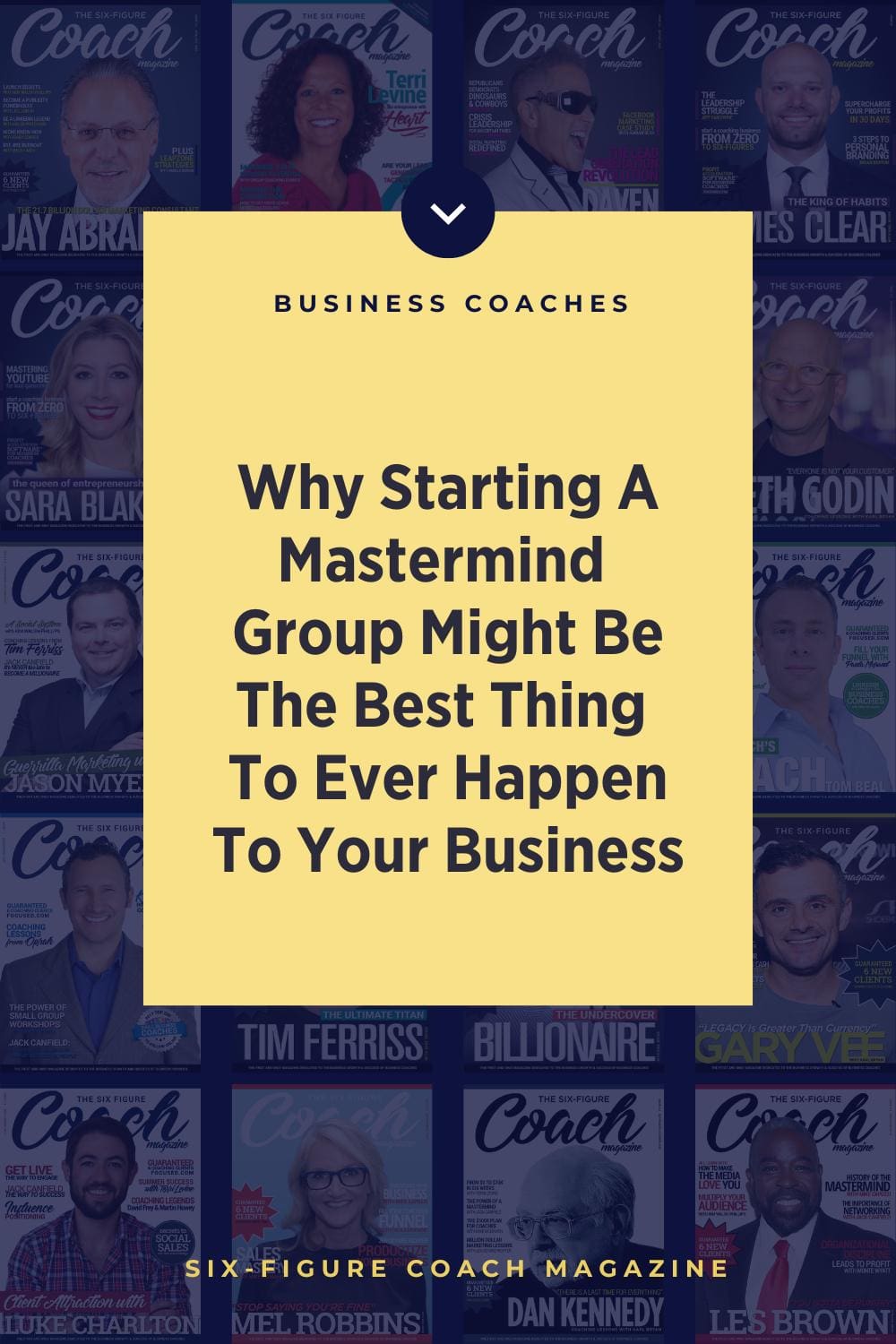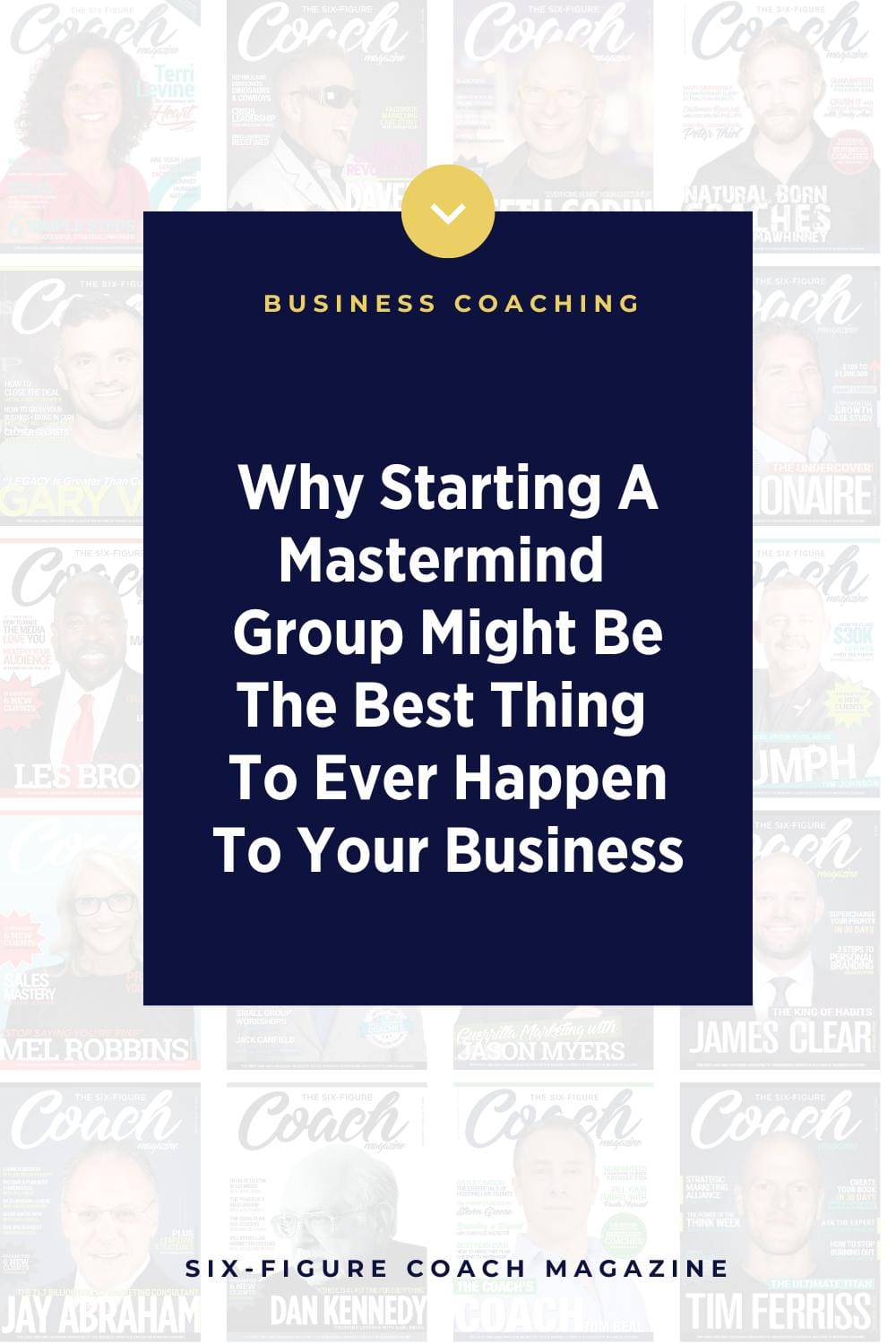Why Starting A Mastermind Group Might Be The Best Thing To Ever Happen To Your Business By Becky Auer
If you’re new to coaching, you’ll soon discover two things:
- You have a limited number of hours to spend with clients
- There are many more people in need of your help than you have time to work with.
The first problem affects your income. The second, your mindset. And both are tough in you want to grow your business.
Because if you’re like me, you got into coaching because you wanted to help people, and sometimes that seems pretty tough with time limitations.
I’m sure now that I’ve pointed it out, it seems obvious that your time is limited.
After all, everyone has the same 24 hours in a day.
But what a lot of new coaches fail to consider is all the time you have to spend on things that aren’t coaching.
– Strategy sessions or discovery calls that aren’t paid for…yes, they often lead to a new client, but if you’re spending 30 or 60 minutes on the phone with each potential client, that can eat up a lot of your tim,e let alone a lot of your energy!
– Support…if you’re like most solopreneurs, you’re likely still handling a lot of support issues yourself. Clients and potential clients call and email frequently, taking time away from those one-on-one calls.
– Marketing…keeping your pulse on your in house email list, your Facebook group, Pinterest, Instagram, LinkedIn, and others, takes a lot of time. And even though it’s necessary to keep your leads coming, this is all “unpaid” time as well.
So let’s be honest. When you take all of this (and the other billion tasks you perform as a small business owner) into consideration, your available time for one-on-one calls is pretty limited.
For most coaches, it’s less than a few hours per day and that’s if you’re highly motivated and really organized.
But what if, for one hour each week (or month), you were able to reach 10 or 20 or even 60 people?
Now instead of filling your day with one-on-one calls, you can work fewer hours while reaching more people and earning more money.
That’s the beauty of a mastermind program. Some call it group coaching too. But I call it mastermind.
One of the BEST benefits to mastermind groups that many coaches fail to see: the upsell and the future sales to these members.
A group coaching or mastermind program gives potential new clients a way to get to know you and your coaching style without a huge investment.
And it allows you to move those clients into higher-end programs, such as your one-on-one coaching, a VIP day, or an exclusive retreat. If you want to.
By hosting primarily mastermind groups, you can serve a larger audience, but you can fill your available high-end coaching slots with action-taking clients who already know and love you.
Now, creating a mastermind program might seem overwhelming. You don’t know where to start, right?
Yes, there are a lot of moving parts, but if you don’t get the planning and implementation right, it will fail. So, let’s go over this in detail.
Step 1: Define Your Program Focus
The best mastermind programs all have one thing in common: they dive into a single issue, systematically resolving all the pain points their target audience is experiencing.
Your goal is not to create a massive, all-encompassing program that takes members from…
- Deciding on a business model
- Creating a website
- Setting up an affiliate program
- Recruiting JVs
- Hosting webinars
- Getting speaking engagements
- Writing a book
- Getting interviewed by a celebrity
Holy Smoke! That kind of overwhelming coaching program might sound awesome, but the reality is, you’ll turn off more potential clients than you’ll attract.
They’ll either have no interest in most of the content (i.e., they want to write a book but already have a website and a business mode and don’t care about webinars), or they’ll find the very thought of it to be far too much work. (wouldn’t you after reading that list?)
It’s hard to provide great value to your members on every single subject on this list. No one can.
Instead, choose the one or two areas where you are:
- Endlessly curious—do you spend your free time studying the subject and testing theories?
- An expert—do you have proven success?
- Passionate—do you love the subject so much that you can talk about it forever and provide endless details?
Yes, you can still be passionate about other subjects. You may be an expert at branding and love building websites and also love helping busy moms start a small business from home.
These two things are related, but they’re better off as separate programs, even if they share the same ideal client.
By creating different programs that focus on a single subject, you’ll be able to better serve your members with valuable insight, rather than encouraging them to rush through each section to get to the next.
If you have already had mad success in an area, you can start your group focusing here. Then expand to an ‘overall’ group if you so desire.
Step 2: Identify Your Ideal Client
Want to know the biggest mistake new (and even established) coaches make with their group or one-on-one programs? It’s thinking you know what your members want to learn or be taught.
When you narrow your program’s focus, it helps you provide better value to your clients, but you should narrow your client list as well.
It sounds counterintuitive, right? After all, don’t you want more clients? Of course, you do.
But they have to be the right clients. If you fill your funnel with less-than-ideal clients, you’ll:
- Sell fewer memberships. You might not sell any at all.
- Waste time on marketing and discovery sessions that don’t work.
- Waste money on emails that don’t get opened and blog posts that aren’t read.
And all that wasted time and money lead to frustration and a sense of ‘let me just tear my hair out,’ not only for you but for those you’re communicating with as well. Think about it.
If you continually receive marketing messages from someone who is not resonating with you, how does that make you feel? Don’t do that to potential your potential clients. They aren’t all your people. And that’s fine.
Instead, concentrate on narrowing your focus to that one ideal client who desperately needs your help and with whom you have a connection.
When you get this part right, you’ll build a list of active, responsive prospects who seek out your newest programs and who will happily buy everything you offer.
Now, how do you discover your ideal client? It’s easy. You probably already know them.
First, think about your current clients.
- Who among them is your favorite? What is it about them that makes you happy to get on Zoom or the phone with them?
- Who do you dislike? Maybe they fail to follow through with assignments or push back on every suggestion you make, or maybe you simply aren’t excited about their business model.
- And remember: some people just want to ‘belong.’ You make the decision on whether you want them in your group or not.
Step 3: Outline Your PROGRAM
Now that you know what you’re going to teach and to whom, it’s time to outline your mastermind program.
Don’t worry about the format quite yet; we’ll cover that in the next section. For now, let’s focus on the content, starting with the pain points your ideal client is facing right now.
You want to outline your program because you want to make sure you are providing value for your clients.
But it’s also helpful when it comes time for marketing.
Decisions to join are often made based on avoiding pain, so any time you can offer relief from a problem that your audience has, you’ll have a much easier sale.
Finding those pain points is easy for anyone who surrounds themselves with their ideal client, as all good coaches do.
Pain points can be discovered in the form of questions in:
- Private and public Facebook groups
- Forums
- Your email
- Marketing emails from other coaches in your niche
- Comments on YouTube videos
- Your one-on-one sessions
- Discovery sessions or strategy calls
You’ve also likely been where your client is today and worked through it successfully, so ask yourself:
- What drove me to success?
- What kept me awake at night during the process?
- What frustrated me nearly to the point of tears?
These are the same things your market is struggling with right now, and because you’ve been through it, you’re the perfect person to take on these issues and help your clients past them.
Once you know the pain points, it’s time to create a step-by-step training program.
Begin by writing out your ideal client’s biggest pain points, then—in one sentence each—develop three solutions.
For example, if you coach moms who are homeschooling their kids, a pain point might be ‘to-do list’ overwhelm.
She’s got so much going on that she feels like her life is a never-ending list of priorities that never seem to get done.
Your solutions might be:
- Block time on your calendar to prioritize your to-do items and appointments.
- Practice saying “no” to invitations you don’t want to accept.
- Create a chore list for your kids, so you can stop spending time on laundry and dishes.
Each of these solutions can then be a module in your mastermind program. All that remains is putting them in order.
In this case, saying “no” is the top priority, so that would be week 1. Getting help around the house is week 2, and organizing the calendar is a natural step three once those other two items are taken care of.
Step 4: Determine Your Format
There are three considerations when it comes to deciding on the format of your mastermind program:
- What your ideal client prefers
- How you want to deliver your content
- What you are most comfortable with
First obviously is your client. They have very specific needs and preferences, and you’ll want to make sure you offer them exactly what works best, rather than asking them to be flexible.
Right now, everyone is used to jumping on a Zoom call. If not, they’ve been left behind.
Looking at your ideal client, what do you know about their learning style?
- Do they love audio so they can download it to their phone for listening on the go?
- Are they so used to Zoom meetings now that it fits in easily with their lifestyle?
- Do they hate long videos but appreciate short, bite-sized training modules?
- Are they a “take action” type of person who wants to check things off a list?
What about your content? What type of format will work best to get your point across?
You can also use a combination of formats to help members achieve their goals. For example:
- Zoom meetings with follow up emails sent to them with resources mentioned on the training.
- Live webinar training with downloadable worksheets and checklists to help members make use of the information.
- Audio interviews with a PDF guide that goes into more detail, almost like show notes from a podcast.
Finally, what about you? Which formats are you most comfortable with?
If you hate video, you’re not likely to finish creating a program that requires hours and hours of on-camera time, so it’s important to figure out what you love and format the meetings to fit your lifestyle.
And remember: disliking a specific format doesn’t necessarily prevent you from using it. You can:
- Purchase pre-written/recorded content
- Outsource it through sites like Upwork or Fiverr.com
Step 5: GIVE ‘Value Add’ Bonus Training
While it’s important that you know a bit about your topic, you don’t have to have a Ph.D. to be successful.
In fact, remember that you just have to be a little bit better than your members.
There are tons of other ways to create highly valuable training, even if you don’t consider yourself an expert. One of the best is to invite actual experts along for the ride.
Let’s say your program helps new coaches find more clients, and then a part of your overall plan might be using Linkedin to drive traffic.
LinkedIn outreach is a huge subject all by itself, and chances are you aren’t an expert in it.
And LinkedIn is always changing. But there are several people who are experts, who would be happy to provide training to your members.
The key is to include complimentary training that enhances your mastermind program.
Step 6: Create Your Forms and Downloadables
When you decided on the format of your mastermind program, you may have already decided to include worksheets, handouts, or checklists in your training.
These are extremely valuable to your members, so if you haven’t planned them out yet, it’s time to do that.
Downloadable content comes in many forms, such as:
- Checklists
- White papers
- Worksheets
- Calculators (Microsoft Excel spreadsheets, as an example)
- Slide decks
- PDF’s
- Templates
- Swipe files
One easy way to create downloadables for your clients is to simply look at the tools you use in your own business.
Chances are you make good use of checklists and templates as you go through your day, and these can easily be repurposed for use by your clients.
One thing you should always do is maintain your branding.
Clients will very likely download their printables and store them in a folder on their computer or in the cloud.
Days, weeks, or months from now, when they re-open the document, it should be absolutely clear where it came from.
Consistent branding is the key and should include:
- Your logo in the header of a document or on the first page of a slide deck
- Your brand colors and fonts
- Your copyright information in the footer or on the first page of a slide deck
- Your unique brand style, such as your preferred headshot, signature block, or tagline
You can be sure your downloadable content is always on-brand by creating templates in Canva, Word, or Powerpoint.
Then make sure to use your template for new content.
If you’re not familiar with creating templates, think about hiring a brand expert from Fiverr.com, Upwork, or someone locally to help you with this step.
It’s an investment that will pay for itself quickly, as you’ll use your templates over and over again.
Step 7: Plan Your Launch
Even the most amazing mastermind programs won’t sell themselves. You will need to put in a little planning here to get the biggest impact.
The good news is, once you get the pieces in place, you can rinse and repeat to fill more groups if that is your desire.
The first stop is your existing list. (you do have an existing list, right?) Whether it’s a mailing list, Facebook fans, podcast listeners, or Instagram followers, you’ll want to start getting them excited about your upcoming launch.
Take the opportunity to “tease” about your next group in the days and weeks leading up to the big launch by posting about it on social media and emailing your list.
If you’re feeling stuck, ask for opinions on what they’d like to see covered inside a mastermind program.
Also, consider creating a VIP waitlist for those who are interested. A simple landing page with an opt-in will work.
Collect their names and email at a minimum. Send the link out on your social networks, through email, and ask people to register to receive a VIP invitation.
You can send out an early announcement to those who register and even offer them a discount for taking action before you open the doors to the public.
Mastermind groups have a GREAT place in your arsenal of coaching. Especially if you want to scale quickly, help as many people as possible, and have a ‘life.’

About Becky Auer
Becky Auer has started 3 multi-million dollar businesses. The last was a Japanese Steakhouse and Sushi Bar that she took from $0 to $6.5M in just over a year and kept it there until she sold it. Becky runs group coaching and mastermind groups as well as coaching private clients. For Free Resources, go to BeckyAuer.com.








